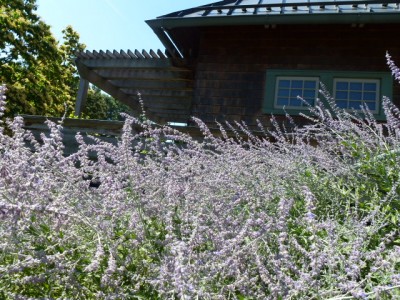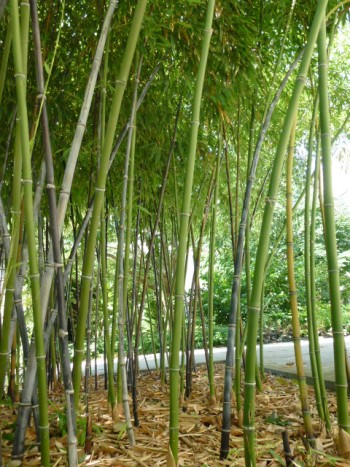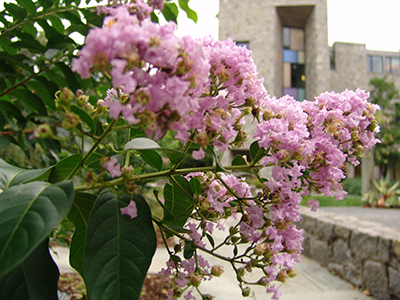Plants of the Week: July 25
Perovskia atriplicifolia
Before entering the front door of the Wister Center, one will likely notice a strikingly beautiful mass of Perovskia atriplicifolia herbaceous subshrub in full-bloom. Also called Russian sage, Perovskia atriplicifolia is perennial, produces spikes of fragrant, blue blooms during midsummer, and can rapidly grow a bit over 5 feet tall. Perovskia atriplicifolia is native to steppes and high mountains, likes full sun and actually prefers nutrient-poor soil; for that reason, Russian sage is being considered as a candidate in phytoremediation efforts.
Similar to other members of the Lamiaceae family, Perovskia atriplicifolia produces essential oils with a variety of applications including: antibacterial, antidiabetic, and analgesic medicine, a treatment for dysentery, and vodka-cocktail flavoring. The flowers themselves can be eaten in salad or pressed to make blue dye; they also attract bumblebees in scores. Like a Swiss army knife, Perovskia atriplicifolia is a plant of many uses. Photo credit: D. Alvarez
Phyllostachys nigra
Having always had an interest in Asian culture and aesthetics, I took karate growing up. The first weapon art I was taught was the use of bamboo sticks, so whenever I see bamboo plants, I remember the fun I had learning karate. Phyllostachys nigra or black bamboo can grow up to 36 feet tall and out to 20 feet for its spread; it prefers partial sun and moist, rich soil. New shoots start out green but turn gold about their second year. Usually by the third year, the culms (stalks) have become their iconic black color. Phyllostachys nigra makes a lovely hedge or crafting material, and the new shoots can be eaten as well. Though not considered invasive, black bamboo is best enclosed inside of its own planter or garden space. Come see our patch at Scott Arboretum in the Isabelle Cosby Courtyard! Photo credit: D. Alvarez
Lagerstroemia ‘Biloxi’
Around this time of the year until October, Lagerstroemia ‘Biloxi’ is in full-bloom, producing clusters of pretty, pink, fragrant, fluffy flowers by the Isabelle Cosby Courtyard. ‘Biloxi’ crepe myrtle, a multi-stemmed, deciduous tree, likes full-sun, rich, acidic soil, and consistent watering to keep the soil moist. It can grow up to 30 feet high and have a spread of 15 feet. The leaves start out bronze in the spring, turning to green in the summer, and finally orange in the fall. The sweet-scented, colorful flowers attract bees, and can add a splash of color to any garden vista. Photo credit: R. Robert








No Comments